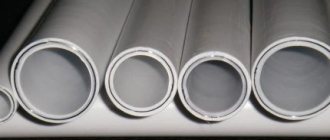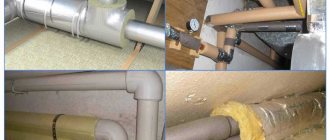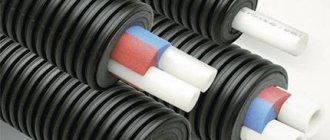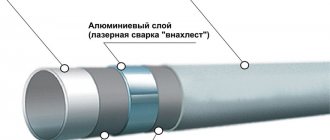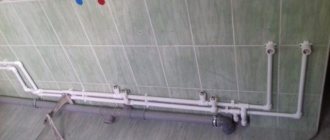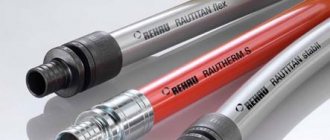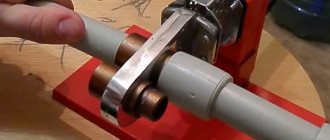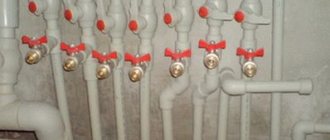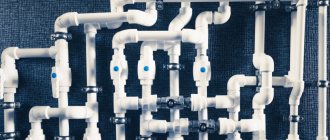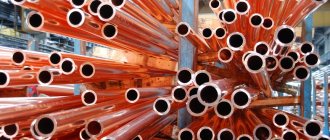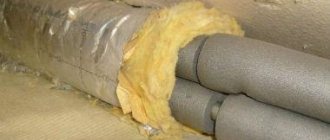Due to their high physical characteristics, metal-plastic pipelines have found wide application in various areas of household services. One of their main distinguishing features is that the installation of metal-plastic pipes is accessible to both specialists and ordinary users without special tools.
In order to lay a pipeline line with the help of hired workers, and even more so independently, it is useful to study the basic physical characteristics, as well as the dimensional parameters of plastic pipes. To install a metal-plastic pipeline, you should know the existing installation methods and the tools used for this.
Rice. 1 Pipes made of cross-linked PEX and heat-resistant PE-RT polyethylene - structure and appearance
List of tools required for work
Having made the calculations and purchased the required amount of material, you should stop at purchasing the most necessary tool. To install metal-plastic pipes, especially with your own hands, just pliers and a flat-head screwdriver will not be enough, so it’s better to spend a little money, but have everything you need at hand.
What you must buy:
- Pipe cutter The tool that should be purchased first. Using this device you can achieve smooth edges without any burrs or other damage.
High-quality and durable pipe cutter
- Press jaws. They belong to the category of crimping tools, using which you can connect two pipes by placing a press fitting on them.
- Calibrator. The calibrator is used for proper flaring, during which the surface of the metal-plastic product is not damaged.
Inexpensive calibrator
- Bevel remover. If the cut was made incorrectly or crookedly, then using a chamfer remover it can be given the correct shape.
- Set of open-end wrenches. For greater savings, you can purchase one adjustable wrench.
After collecting the necessary tools, you can proceed directly to the connection. But to do this, you should familiarize yourself with the methods of connecting or soldering metal-plastic pipes.
What is a compression fitting and how to use it
Compression fittings are often used not only by DIYers, but also by professional plumbers. So why are they so popular? The answer is simple: because of the mass of positive qualities and ease of installation.
Compression fitting
- To install a compression fitting, no specialized equipment is required; all you need to do is have an adjustable wrench on hand.
- Such products even tolerate burrs along the edge, so a pipe cutter may not be used here.
- There is no need to use a bevel remover or calibrator.
The installation sequence of the compression fitting is as follows:
- The nut, which has free play and is tightened after installation, is placed on the end of the product.
- The shank is wrapped several times with tow to make the connection more tight, and inserted into the product.
- A fixing nut is placed on the base of the fitting. Use one wrench to hold the body of the product, and the second to tighten the nut.
The simplicity of such installation can be deceptive and not many home craftsmen are able to make the correct connection the first time. When tightening the fixing nut, pay attention to the force applied, as the body of the compression fitting may crack.
Important! Before installing the product, be sure to check the presence of all O-rings, as well as fitting gaskets, which provide the required level of sealing. If they are absent, the connection will not be reliable and will require immediate replacement.
*
Installing a push fitting with your own hands
The most simplified product, for installation you don’t even need an adjustable wrench, just the right hands. The installation sequence is as follows: take the push fitting and insert the pipe into it until it stops. To determine the force, just look into the special control hole - as soon as the end of the product appears in it, you can stop pushing.
Push fittings for quick installation
Push fittings are especially relevant when the question arises of how to quickly connect a metal-plastic pipe to a metal one. There are many advantages of this connection:
- As mentioned earlier, no tools are required for installation. Only push fittings and products that need to be connected.
- Push fittings have a long service life and are made of durable and reliable materials.
- Can be wall mounted, unlike compression fittings. It’s very convenient when you don’t want to constantly monitor and tighten the connection.
Push fittings have a lot of advantages, but they also have one significant drawback - high cost. It is better not to purchase cheap products, since their service life decreases in proportion to the price. You should contact a plumbing store where you can choose connections from reputable manufacturers.
Decoding of production markings
The marking contains basic information about the characteristics and purpose of the pipeline. The sequence of values may differ from manufacturer to manufacturer.
Standard designations:
- name of the manufacturing company;
- production standard, certificate number;
- type of materials used;
- nominal dimensions;
- maximum permissible pressure;
- environment suitable for transportation;
- additional operating conditions (temperature).
At the end, the batch number, shift number and production date are displayed.
When assembling the pipeline, it is advisable to leave the surface of the pipe with markings within visual reach. In the future, information about the material may be needed
Press fittings
Very similar to compression products, but with some differences. Press fittings can be called a more productive form of connections, since they have a long service life, but require the use of appropriate tools. If installed correctly, press fittings can be installed in walls.
High-quality and reliable press fittings
Main differences from compression products:
- Low seating of the rubber seals, resulting in better tightness. The gasket tightly compresses the metal-plastic product along the internal diameter.
- The fixing nut was replaced by a crimp sleeve, for clamping which press pliers are used. The sleeve is made of stainless steel, not affected by moisture in the water supply system. It is precisely because of the use of a crimping tool that press fittings can be mounted in walls.
The installation sequence is the same as in the case of compression products. Place the fitting onto the end of the product and clamp it using press pliers. The installation process is simplified due to the absence of a fixing nut.
Manual press pliers for crimping fittings
This type of fitting has practically no disadvantages, except for the high cost of the tool. The price of pliers for crimping sleeves on metal-plastic pipes starts from 6,000 rubles. The category of professional tools is already above the 10,000 mark.
Basic mistakes
When connecting pipelines made of polypropylene and metal-plastic, the following mistakes are often made:
- apply great force, which leads to a decrease in the internal diameter;
- they make a loose connection, so a leak occurs;
- do not use sealing materials - flax tow, plumbing paste, silicone sealant.
One of the mistakes is also non-compliance with the temperature conditions and heating time of PP parts, when it is necessary to solder polypropylene fittings elements with PP pipes. As a result, it is not possible to create a monolithic joint if the polymer has not been heated sufficiently.
When the plastic overheats, the products become deformed and the internal diameter decreases. Therefore, the system throughput is reduced.
Soldering of metal-plastic pipes
*
The main types and methods of connecting metal-plastic pipes were discussed above; now you need to move on to soldering. You should immediately outline the list of tools required for soldering metal-plastic products. You will need:
- Soldering iron or welding machine for soldering plastic, polypropylene and metal-plastic products. The average cost is from 1500 to 2500 rubles. A higher price means additional display or multiple modes.
- Sealant. It is better to choose a sealant that is not affected by high temperatures, but as a cheaper option you can purchase a simple one.
- Tow. Which is used in almost all plumbing work.
Soldering irons or welding machines are divided into home and professional models. Their main difference is that professional soldering irons can solder pipes with a diameter exceeding 50 cm, but for home needs this will be overkill.
Special apparatus for soldering metal-plastic pipes
How to properly solder metal-plastic pipes:
- Cut the pipe evenly, ensuring that there are no burrs along the edges. If the edges are uneven or the surface is damaged, then soldering will not bring a positive result, and the whole process will have to be repeated again.
- Turn on the soldering iron and heat it to the nominal temperature. Use the cone-shaped part of the tip to heat the outer part of the pipe. For different diameters, a corresponding nozzle is installed on the soldering iron.
- Install the nozzle one size smaller than the previous one and thoroughly heat the inside of the metal-plastic product. The nominal temperature at which pipes are soldered is 180 degrees Celsius.
- After heating the outer and inner parts, connect the two pipes together. Wait until the products cool down. The soldering is now complete.
Types and selection of equipment
Soldering equipment is a device that uses high temperatures to create a reliable, hermetically sealed connection. Different equipment can be used for welding plastic and cast iron products.
There are 2 main groups of equipment for welding polypropylene:
- Mechanical devices. They are used when the volume of work is large and a lot of labor is required.
- Manual apparatus. Can be used for small diameter pipes for independent work.
The mechanical device includes a support frame, a block, and a hydraulic unit. There are grips on both sides of the equipment. In their middle there are liners. Their task is to correctly distribute pressure and centering.
It is better to use 2 people to solder pipes
The ends are aligned using an electric trimmer. It is a rotating disk with double-sided knives. The main element of the unit is the electric heater. It is installed inside and is a disk with a heating element.
Home soldering can be done using hand-held devices. Mechanical fixtures are more suitable for factory purposes.
To perform soldering manually, you need to purchase a special iron. The operating principle is reminiscent of a household appliance, although the appearance of the devices is different. The design of the iron includes a heating plate, a thermostat and a handle. The plate has two holes for soldering parts. Due to the Teflon coating, hot plastic does not stick to the device.
How to bend a metal-plastic pipe correctly
Very often, after connecting the pipes, the structure has to be bent in the right direction. If the technology for installing and connecting metal-plastic pipes is selected with high quality, then this will not affect the fitting or soldering in any way. But still, it is better to bend the pipe correctly, and there are several interesting ways to do this.
It is best to use a hair dryer. It is enough to slightly heat the area that needs to be bent, and then use your hands to give it the required shape. The heated metal-plastic pipe bends easily and does not deform. It should be remembered that the pipe should not be allowed to overheat, which can lead to damage.
Sometimes rigid springs, precisely selected in diameter, are used to bend metal-plastic products. The spring is not put on the pipe, but pushed inside it, this allows you to achieve the necessary rigidity. The middle of the bend and the middle of the spring must coincide exactly. And so that you can get it out later, a metal wire should be firmly tied to one end.
You can also use sand; it must be poured inside the metal-plastic product so that it is distributed evenly throughout the entire pipe, without hollow spots. Then the area chosen for bending is heated a little and given the desired shape with a smooth movement. When using sand, metal-plastic pipes do not deform and remain intact along their entire length.
If you need to bend products frequently and in large quantities, then it is best to purchase a pipe bender - a tool specially made for this purpose. Of course, its cost is high, but it allows you to simplify the task as much as possible. Some home craftsmen make pipe benders at home using scrap materials.
An example of an inexpensive pipe bender
What to pay attention to
Temperature conditions for soldering are described in the instructions for the tool. Modern products have an automatic heating mode depending on the size of the installed network and the welding depth. On previous brands, the heating strength was selected manually.
At what temperature should plastic pipes be soldered? When soldering polyethylene risers, we set the temperature regulator at around 220 ° C, for polypropylene risers - 260 ° C. There is an indicator on the heating mechanism that shows the device is ready for use. The indicator lights up only in heating mode.
The duration of soldering depends on the circumferential radius of the pipeline, and can range from 5 to 40 seconds. The ends should not be overheated. This can cause a blockage to form at the adhesion site.
If you need to install a water supply of the same size, you should not overpay for the number of nozzles and the presence of a temperature mechanism.
If you plan a large volume of long-term production using networks of various sizes around the circumference, then we purchase a universal device for connection with the latest technical capabilities and characteristics.
